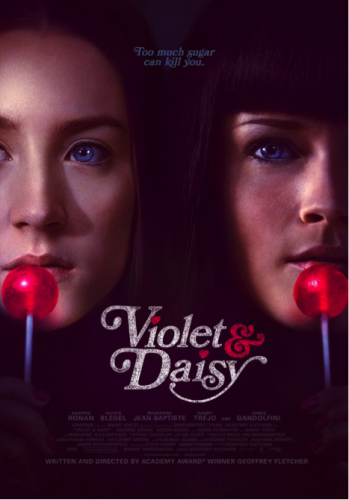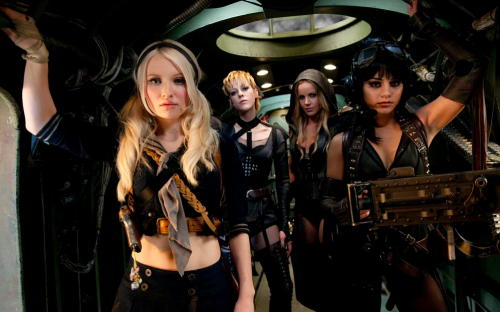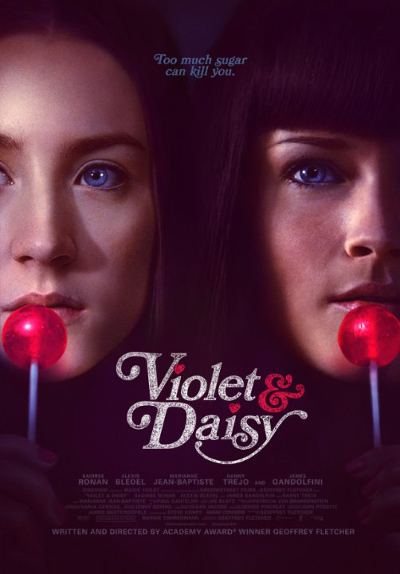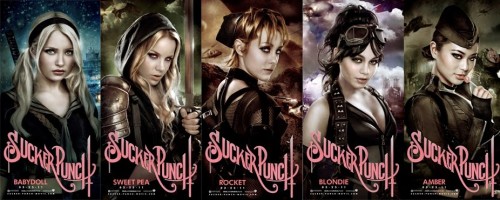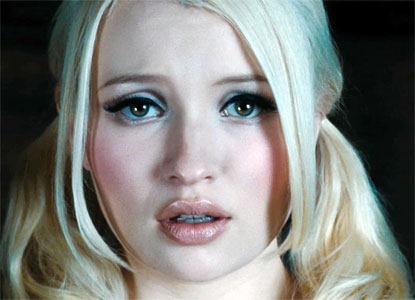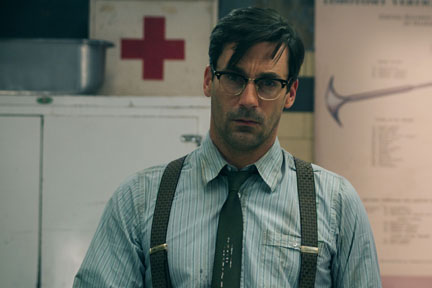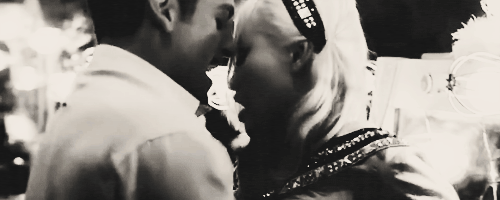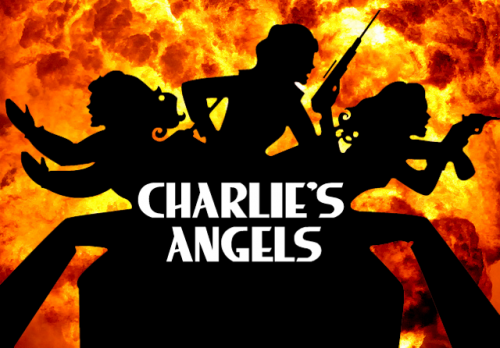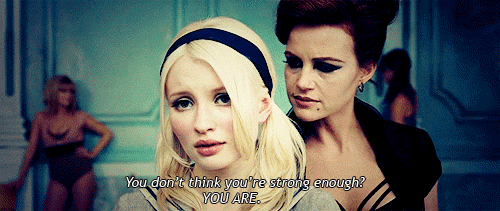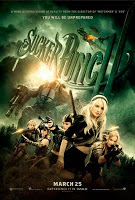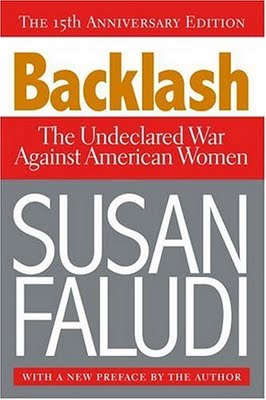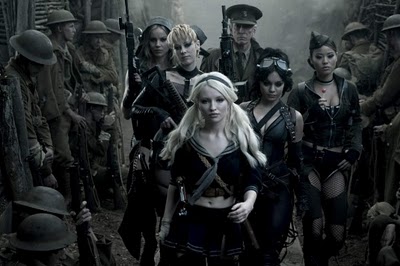This guest post by Caroline Madden appears as part of our theme week on Violent Women.
Violet & Daisy is written and directed by Geoffrey Fletcher (Oscar-winner for Precious) and stars Alexis Bledel and Saoirse Ronan as the title characters. The stylized Tarantino-esque film, inspired by Thelma and Louise, oscillates between genres. Mostly, it is a coming-of-age story of two teenage assassins, with a play-like structure, scenes with heavy dialogue occurring one room between the girls and the man they’ve been sent to kill, played by James Gandolfini. The snafu is that they grow to care for him, making it hard to get the job done. And they need the money to buy dresses from their favorite celebrity line, Barbie Sunday.
Violet & Daisy subverts the notion that girls are not a part of such nastiness–the mafia, crime organizations, robberies, and murder. Fletcher magnifies the girlish and childlike imagery to challenge the viewer on this. It is clear from the poster–two girls holding bright cherry red lollipops, and the tagline “Too much sugar can kill you”–that the film will be fetishizing juvenile images.
These images run rampant throughout the film: blowing bubblegum, playing patty cake, yo-yo tricks, dressing as uniformed schoolgirls. One scene shows them lusting after the oatmeal cookies Gandolfini’s character bakes. They gulp down glasses of milk and reveal their milk mustaches. The character of Daisy personifies the film’s juxtaposition of violence and girlhood. Daisy loves cute animals and doesn’t understand Violet’s dirty jokes. The twist is even that she has not really killed anyone, thus remaining innocent of all crimes. The opening scene displays the most daring oppositional iconography — the young girls dress as nuns, the ultimate image of pure goodness, while having a shoot ‘em up with a gang.
Violet and Daisy use their girlhood to their advantage; the men around them underestimate their skill or cannot fathom their participation in such acts. The girls often sneak past the cops right under their noses. After a hit, they throw their nun disguises in the trash and round the corner in new matching gym outfits, playing swords with sticks (another child image). When Violet is in a store after a shoot-up, the cop questions her as a witness. Violet taunts him by asking, “What makes you think a girl can’t be in on it?” The cop obliterated any idea of her involvement because of her sex and young appearance. The rival gang that is also after Gandolfini’s character, dangerous and hardboiled men, mock Violet and her boss. They joke that he must have been too deep into the economic depression to “send a cunt like you to do a man’s job.” We have male characters erasing or overlooking Violet and Daisy’s actions because of their sex and gender, assuming that it defines their capabilities. Violet and Daisy prove themselves to be more than capable of their job, taking it seriously and referring to themselves as “career women.”
Violet and Daisy are primarily detached from their hits, usually murdering men who have committed a crime or a grievance against their boss. However, there is one instance of vengeance violence. It is revealed, through Daisy’s initial misunderstanding then realization, that Violet was raped by the rival male gang- all significantly older men. Violet does end up murdering these characters- though out of mere circumstance rather than seeking them out in order to enact revenge. They are also after Gandolfini’s character, coming to his home and threatening him and Daisy. Violet saves the day by sneaking up behind them and shooting them all. The film does not frame incredible emphasis on this aspect of vengeance, for she seems to be enjoy inflicting death no matter who it is. This unnecessary trope could have easily been left out of the narrative, there are other ways to establish a rival group of assassins. However, I do appreciate that there was no exploitative flashback scene depicting the act.
We are disturbed by women who commit violence; they violate our culture mores and assert their independence and agency in threatening ways. Our disturbance is greater when it is a young girl, expected to be pedestals of purity and unwavering goodness. This is evident in the film’s R MPAA rating, for not only violence but “disturbing behavior.” Naturally, their fear is manifested in these child-like young women who gleefully and willingly glorify murder. One scene features the girls stepping on dead bodies, exclaiming joyfully time for the “internal bleeding dance!” The most violent scene features Alexis Bleldel wielding a fire extinguisher as a weapon, the blood splattering on screen as we hear the thunk of metal hitting bodies. However, most of the violence–even the ramifications of the fire extinguisher–is off-screen. Thus the idea of young women doing this is just as disturbing as viewing it.
Yet while some may be disturbed by violence in girlhood performance, we have seen other similar characters on screen. We turn to Natalie Portman’s performance in The Professional and Chloe Moretz in Kick Ass. In The Professional, do we accept the world-weary child, who dares Leon to sniper shoot the passerby, because she evokes adulthood via mannerisms? Hit Girl from Kick Ass seems to be played for farcical shock, and is far more violent than anything seen in Violet and Daisy. Audience members marvel that an 11 year old girl, who should be playing with Barbie dolls, is instead calling men cunts, stabbing swords through their chests and cutting off their legs. A.O. Scott’s New York Times review of Violet & Daisy scolds it for “hav[ing] nothing to respond to beyond the spectacle of girls with guns.” While I do not think Violet & Daisy is nearly as exploitative as Sucker Punch, we must consider its elements. Sucker Punch reads as a masturbatory fantasy of girls wielding guns and swords as a means of giving themselves agency and vengeance over the men who exploit them. The main character, Baby Doll, also appropriates girlish imagery, creating this strange eternal child who is taken advantage of repeatedly in highly sexual ways. It is a spectacle in every way imaginable, but I do not think Violet & Daisy fetishizes violence nearly as much, for the plot is centered on tripping up their physical ruthlessness by forming a genuine emotional connection with their victim.
Violet & Daisy is a film that plays with its genre and is hard to read. Is it a fantasy? Or a commentary on violence? Should we take it seriously? One thing is clear- it deliberately engages with child-like motifs to challenge our views about girlhood, depicting young girls as capable agents enacting violent acts. Child or childlike assassins have been used in film before to comment on both societal terrors and curiosities. Looking at Violet & Daisy, I feel that it uses child-like imagery to amplify our cultural fear of violent women, as evident by the men who underestimate their mental and physical capabilities. A woman wielding a gun is terrifying, but a young girl wielding one is even more so, and Fletcher augments that taboo by pervading the film with childlike imagery.
Caroline Madden has a BFA in Acting from Shenandoah Conservatory and is currently an MA Cinema Studies student at Savannah College of Art and Design. She writes about film at Geek Juice, Screenqueens, and her blog. You can usually find her watching movies or listening to Bruce Springsteen.
